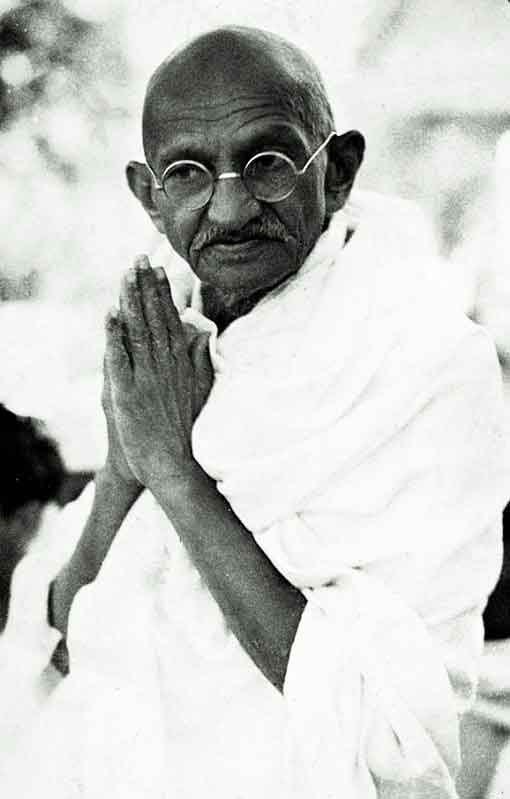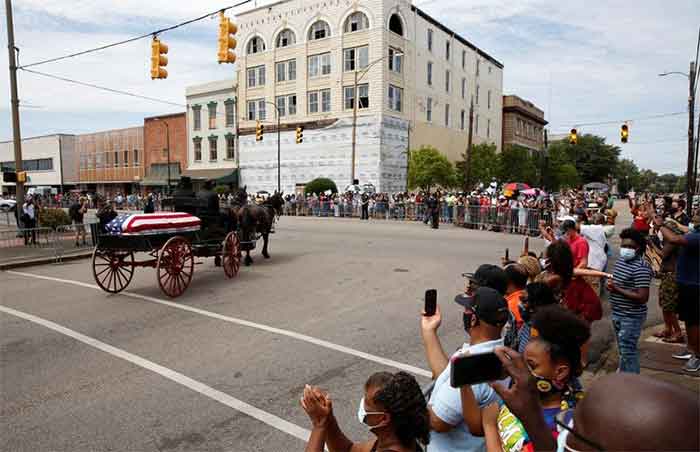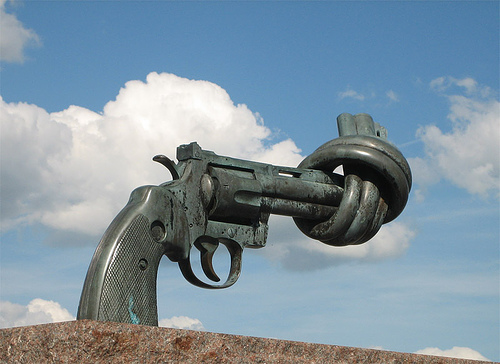
Was Mahatma Gandhi a Coward, Who Preached Non-violent Struggle Against the British Due to His Cowardice?
India was attacked by Mahmud of Gazani in the 11th century. He attacked 17 times. The last time was in 1025. He robbed Somnath Mandir and carried its wealth to his own country. But none of the Hindu rulers could stop him.
Later, Gori attacked India in the 12th century and defeated Prithviraj. Indian rulers were no match for him. While returning home, he was killed by one of his own men while praying. Then, in 1206, his slave Qutubdin Aibak became India’s ruler.
Thereafter, India remained under the Muslim rulers from 1206 to 1526 before the Mughals arrived. When Babur attacked Delhi, he did not fight and defeat a Rajput king, but Ibrahim Lodi, another Muslim ruler. The Mughals ruled India from 1526 to 1857. No Rajput ruler could defeat the Mughals during 1526 to 1857.
Even in 1857, the Mughals were defeated by the Englishmen though the Mughal Emperor was supported by many Indian Rajas including Janshi ki Rani, Tatya Tope, Beer Kuer Singh. It is fair to pay tribute to the Indian rulers, who fought the Mughals valiantly, but must be admitted that they were unable to drive them out of India because the Mughals were much too strong for them.
In fact, after 1206, there was no Hindu ruler, who could defeat the Muslim invaders. Even the East India Company was not defeated and ousted from India by the Indian rulers. In 1857, the East India Company again defeated the Mughal Emperor Bahadur Shah Jaffar though he was supported by several India a rulers.
In 1858, India became part of the British empire. Patriotic Indians took up arms to drive the British out of India, but did not succeed. It is to the credit of the brave patriotic Indians that they continued their armed struggle for independence but had no success.
The last and very effective effort to fight the. British was made by Netaji Subhash Chandra Bose, who joined hands with Hitler, Mussolini and Japan’s General Tojo and formed the Azad Hind Fauj. However, their (Hitler and Mussolini) defeat and surrender of Japan following the dropping of the atom bomb on Nagasaki and Hiroshima by the US dashed Netaji’s hope.
Gandhiji did not begin his life as a political person. He had gone to South Africa in 1893 at the age of 24 as a Vakil to help a Gujarati businessman for earning bread and butter for his family. Within two weeks of his arrival there, he was thrown out of a First Class railway coach because he was not white though he had a First Class ticket. He began his fight against this discrimination right from that moment.
He was again beaten up for insisting on sitting with white passengers in the horse drawn carriage on his onward journey because he had the ticket to sit with them. His fight began against the injustice from that moment.
Imagine the courage of a lonely young man of 24 in a foreign country where he had no rights and no support. He was all alone. All Indians living there had accepted to live like inferior human beings. So, they advised him to accept the humiliation because that was the law of the country. But young Gandhi could not put up with the injustice and humiliation. He began his fight all alone by protesting in the way it was possible.
His non-violent fight inspired the Indian community. He organised them. Gradually, they were inspired and accepted to resist injustice under his leadership. They followed him, organised themselves under his leadership. They even went to jail in protest against the injustice done to them. Gandhiji’s wife also went to jail along with many other women.
Later, he had taken his family also to South Africa. His non-violent fight won him the respect of the world. It also inspired respect for the Indian community in the others also. Till then, the Indians were considered cowardly and contemptible by the Whites. Gradually, the Whites yielded on many issues. The greatest achievement was the respect the Indians inspired in the Whites. Earlier, the Whites had nothing but utter contempt for the Indians. They used to call them cookies and treat them as such.
Gandhiji’s 21 year long struggle ended in Gandhi-Smut agreement of 1914. It brought an end to the 3 Pound Annual Tax that Indians had to pay every year. It made the marriages solemnised in India legal (which was not considered so till then). It also made a domicile certificate enough for the Indians to enter South Africa. In short, they had achieved something which was unthinkable before.
Gandhiji returned to India in 1915 after spending 21 years in South Africa. In 1917, approached by a peasant he went to Champaran to understand the exploitation of the peasants. He was not a leader in India. He did not even go as a Congressman. The British government tried to stop him by prosecuting him and sending him to jail. He again admitted his offence and offered to accept the punishment but firmly refused to obey the order to leave Champaran before completing his mission. But he again succeeded. The British government yielded and granted the relief the peasants wanted.
In short, Gandhiji had been victorious under most difficult circumstances against most powerful governments and had credible reasons to have an unshakeable faith in a non-violent struggle.
Gandhiji developed faith in non-violent struggle because he had won several battles against incredibly powerful opponents. In India, no foreign invader had been defeated and driven out by any Indian ruler or organisation. In an armed struggle, you must be stronger than your opponent. Our revolutionaries deserve our great regard, but they did not prove powerful enough to defeat the British armed forces.
Netajee knew it. So, he did not create an armed force of his own, and instead joined hands with Hitler, Mussolini and Japan’s Tojo. If they had won, Netaji would have succeeded in ending the British rule in India. But they were defeated. Netaji could not succeed though he sacrificed his life fighting for Independence.
Gandhiji believed that if the people could be made free from the fear of the government and bold enough to face lathis, bullet and jail, they would win. They would win because no government could kill thousands of unarmed men and women or put behind the bars lakhs of unarmed men and women for an indefinite period. During the Quit India Movement, lacs were shut in jails, and many were killed. Gandhiji had made the people fearless. They had ceased to fear the government. Gandhiji’s non-violent movement counted on the power of millions of fearless men and women ready to defy lathis, bullets and ready to go to the jail.
The latest example of the power of a non-violent movement is the recent Farmers’ Movement. They remained camping outside Delhi for a little over one year. About 700 sacrificed their lives during the agitation. No issue was made of their martyrdom. There was no excitement. No sensation. Modi had armed forces, paramilitary forces, the regular police and an army of NDA MPs, but he had to surrender. He could not order his forces to massacre the determined unarmed but fearless farmers.
The farmers had Modi meekly surrender entirely due to their non-violent agitation. They could not have otherwise. This is what Gandhiji had advocated and practiced. The success of farmers’ agitation has proved once again that Mahatma Gandhi’s weapon of non-violent struggle is the most powerful weapon against the most powerful ruler.
But it is the weapon of the morally strong and not of a weakling.
It has to be kept in the mind that Gandhiji could achieve freedom from a foreign ruler with a non-violent struggle, which no Indian ruler or armed freedom fighter had been able to achieve in the country’s history.
Prof. Prabhakar Sinha
Hailing from Muzaffarpur (Bihar), Prof. Sinha had a PG Degree in English and Ph.D. in Linguistics from Poona University (1967) studying the grammar of Lepcha language of Sikkim in relation to Bengali, Santhali, Hindi and Vajjika. He retired as Professor of English from RDS College, Muzaffarpur under Bihar University.
Right from his school days in the 1950’s he was involved with the democratic movements of students and suffered fracture and other injuries when police lathi charged agitating students in Patna. He played a leading role in agitation for a judicial enquiry into the police firing on the students of Patna university and later on represented the students in the judicial enquiry headed by the Chief Justice of Patna High court .
Actively involved with the Teacher’s Movement, he was the Convener of Teachers’ Action Committee against the then Congress government which protested police firing in RDS College, Muzaffarpur on 10.12.1966 leading to death of one lecturer and one student and injuries to many others. In a novel manner, he raised funds from the people to represent the case before the judicial Commission which eventually declared the police firing as unjustified. Subsequently he became the Convener of `Teachers’ Action Committee for the defeat of the Congress Party’ during the 1967 state elections. The campaign with the slogan `CONGRESS HARAO’ (defeat the congress) led to the electoral defeat of the Congress party and the formation of the `United Front’ government for the first time in Bihar.
Actively participating in the JP Led 1974 Bihar Movement against the corrupt Bihar Government he was detained under MISA in July 1974 .Detention order was quashed after a few months but he was placed under suspension by the university. When the Emergency was clamped in June 1975 Prof. Sinha joined the movement against the Emergency. Subsequently, he went underground when a warrant for arrest was issued which led to the promulgation of an order for attachment of property was issued. He was subsequently arrested under the Defence of India Act. After a few months in jail, in an unprecedented judgement he was granted bail by a very bold and unconventional judge. The judgment was broadcast by BBC. Following his release from the jail he was once again placed under suspension which was withdrawn only after the emergency was lifted. During this period he remained active in anti-emergency activities succeesfully evading further arrest. During the emergency, Prof. Sinha regularly kept meeting J.P, who lived in Patna after release from jail.
During the Lok Sabha elections in 1977 Prof. Sinha worked as election in charge of Muzaffarpur Assembly segment for George Fernandes, who was in jail in Delhi. George Fernandes won the election.
Though part of the anti Emergency movement, refrained from joining the Janta Party , as joining a party without compromising principles was not possible. Refrained from taking up any position under the government for the same reason.
Prof. Sinha was elected Vice President, Bihar PUCL in March, 1981, became Acting President in October, 1983 on account of the illness of the then President, PUCL Bihar. He was elected as President in 1986, re-elected in 1988 and was President of Bihar PUCL early 1986 to late 1991.
At the national level, Prof. Sinha was elected as a National Organising Secretary in 1988 at Jaipur and as Vice President at Poona in 1990. He assumed charge as President of National PUCL in Ranchi (2009) and was re-elected as President for 2012-14 and 2014-16 terms.
















































